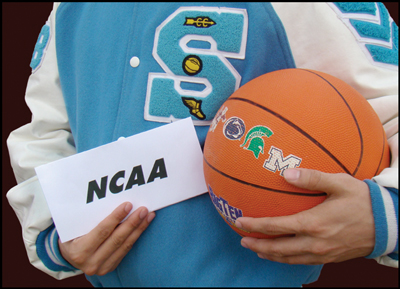SPORTS
NCAA approves aid to student athletes
There have been stories about student athletes whose names were familiar to all. Their tuition was paid by scholarship, but they had no money to buy school supplies, go to a movie or get a new shirt.
It's not going to happen anymore. The NCAA has agreed to make a total of $218 million available to Division I schools through the 2012-13 school year for use by athletes who can demonstrate a need to access the funds.
The settlement is in response to a class-action suit brought by former football and basketball players. The settlement also requires the NCAA to make available $10 million for football and basketball players at major conferences, from 2002 through this academic year, for educational expenses. It includes a $500 and up to $2,500 per year payment for three years.
Funds for the program will come from the CBS $6 billion TV contract for the NCAA basketball tournament through 2013. All student athletes, both men and women in all sports, will be eligible for the aid.
The NCAA urges the schools to use the money for anything it feels is appropriate. Its general council Elsa Cole said, "For example, if a student athlete's grandmother dies, it can be used for travel to the funeral, or for a jacket to wear to the funeral. Or it could be used to buy a computer."
The settlement permits Division I schools to provide year-round comprehensive health insurance to student athletes. Because virtually every school has a health insurance plan for thousands of employees, the cost of adding student athletes will not be too high.

New emergency device for hikers, climbers, others
Whether you're in trouble climbing a remote mountain or just stuck in a car that died, you can now contact family or emergency services when you're out of cellphone range.
The $170 SPOT Satellite Messenger emits a signal to GPS satellites, which can notify SPOT's messaging service. The service then sends a message to family, friends or emergency rescue teams about your current status. It runs on two AA batteries and works anywhere in the world.
SPOT charges a $100 a year service fee. Before a trip, users set up messages on the findmespot.com Web site and hyperlinks to Google Maps that show their locations. Notifications can be sent by email or text message and include latitude and longitude.
The device is somewhat limited but easy to use. About the size of a BlackBerry, it has just three buttons to select from: OK/Check, Help and 911. It doesn't receive messages.
Rodeo bulls being tested for steroids
The steroid scandals have hit the rodeo circuit, but it's the bulls — not the cowboys — who are being tested.
Rodeo stock contractors are said to routinely use anabolic steroids to bulk up their 1 ton bovine athletes. But the steroids have some unwanted side effects. The bulls get bigger and more aggressive, and that's considered good, but some bulls become sterile, cutting their value as breeders. Some say this alone has limited the use of steroids in bulls.
The Professional Bull Riders (PBR) group isn't taking chances, though. It announced a testing program for top bull winners. Stock contractors who violate the no-steroid policy will be fined and sanctioned.
Some golfers object to PGA drug testing, which begins July 8.
PGA Tour commissioner Tim Finchem was joined by two attorneys and a top expert on the World Anti-Doping Agency recently to explain the tour's anti-doping policy. Drug experts have been available to players since the Sony Open, but the informational meeting at Torrey Pines was mandatory.
Players are worried, saying there's no way to tell what's in an energy bar or a protein shake. Charles Howell III says there could be cross-contamination in health products used by players.
More disturbing to players was the process of random drug testing, which is allowed to take place anytime and anywhere, including having a tester come to a player's home. One golfer was indignant because a "collector" followed him to the restroom and pulled up his shirt to make sure he didn't have a urine sample taped there. Another said anyone coming to his home better have a warrant.
The anti-doping policy was announced last November and generated few comments from players. The closer it gets to the July 8 starting date, however, the louder the protests have become.
Pitch counts protect arms of Little Leaguers
Gone are the days when a Little League pitcher could be counted on to pitch a six inning game. Rules instituted in late 2006 limit the number of pitches thrown by an individual to 85.
The change was made in hopes of reducing wear and tear on youngsters' arms. A survey by Little League Baseball found that 70 percent of local league presidents thought there was no negative impact from the new regulations.
Rest requirements call for a two-day rest after a pitcher throws 46 or more pitches in a game. A player throwing 21 to 45 pitches in a day must rest for one day.
A player can't pitch in more than one game a day.
© 2015 TLC Magazine Online, Inc. |